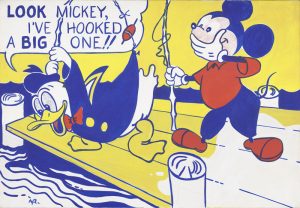Roy Lichtenstein and the End of Abstract Expressionism

 American artist Roy Lichtenstein was an influential force in the Pop Art movement of the 1960s. Along with Andy Warhol, Jasper Johns, and James Rosenquist the group forged a new and varied approach to art making that signaled the end of the Abstract Expressionist movement of the 1950s.
American artist Roy Lichtenstein was an influential force in the Pop Art movement of the 1960s. Along with Andy Warhol, Jasper Johns, and James Rosenquist the group forged a new and varied approach to art making that signaled the end of the Abstract Expressionist movement of the 1950s.
Born in 1923 to an upper middle class family the young artist was raised on the Upper West Side of Manhattan. His interest in jazz took him to the Apollo Theater in Harlem where he made portraits of the musicians with their instruments.

Washington Crossing the Delaware.
Oil on Linen, 1951 click image to view larger
His art studies at Ohio State University were interrupted for a three year period during and after WWll (1943 – 1946) when he served in the US Army. In 1946 he returned to OSU to complete a bachelor’s degree in Fine Arts. Upon graduation he entered the graduate program at OSU and served as an instructor. His art up to this point was influenced mainly by Abstract Expressionism and Surrealism.
His early works were influenced by American history, in paintings such as “Washington Crossing the Delaware” and “The Assiniboines Attacking a Blackfoot Village at Fort McKenzie – 28 August 1833” A canvas painted in 1951 and sold for $95,600 at Auction in 2012.

The Assiniboines Attacking a Blackfoot Village at Fort McKenzie – 28 august 1833″.
Oil on Linen – click image to view larger
After teaching positions in Cleveland, and The State University of New York at Oswego,In 1960 Lichtenstein moved on to Douglass College at Rutgers University as an assistant professor. It was there that he met Claes Oldenburg, Lucas Samaras, Robert Watts, George Segal, Robert Whitman and others who were integral members of the “happenings” art scene of the 1950s and 60s. The influence of these friendships proved pivotal to Lichtenstein’s artistic growth.

Look Mickey.
Oil on Canvas, 1961 click image to view larger
It was in 1961 that Lichtenstein created his first work in the style for which we know him today. “Look Mickey” used the commercial printing style known as Ben-Day dots to create the look of comic book illustrations. Lichtenstein refined this technique throughout the 60’s. Early in his career Lichtenstein was compared to Warhol in that they both strove to make art that looked machine made. It is worth noting that as their careers progressed Lichtenstien’s work became more slick and mechanical, while Warhol’s became looser and showed evidence of the artist’s hand.
In 1961 gallery owner Leo Castelli took note, and began representing the young artist. Viewers, buyers, and the press were often outraged by Lichtenstien’s work, claiming that it was not original art, but merely appropriating cultural imagery. Liechtenstein often reinterpreted paintings by Matisse, Picasso, and others in his cold, mechanical style.

Matisse Still Life w Goldfish
Oil and Magna on Canvas
1972 – click image to view larger
Time Magazine went so far as to dub Lichtenstein “one of the worst artists in America”. His art continually challenged the notion of High Art vs Low Art using large canvases and oil paint to painstakingly “reproduce” images that appeared to be printed rather than painted.
One of Lichtenstein’s most iconic images is his many renditions of “Brushstroke”. A witty swipe at his contemporaries, depicting a hand brushed stroke of paint in an utterly un-painterly technique.

Brush Stroke, signed, ink and dye on smooth card-weight paper, unframed.
(Attributed) click to see larger
Woodshed Art Auctions will offer a small study for one of these paintings at our next Prestige Collection auction on June 21, 2017. Later this summer two more Lichtenstein works will become available:

Lips, signed mixed media painting. Possibly a study for a larger work. –click image to view larger
“Lips”, a signed mixed media painting. Possibly a study for a larger work will be offered at our Prestige Collection sale on July 26, 2017, as will “Classical Still Life”.

Classical Still Life, silkscreen print – click image to view larger